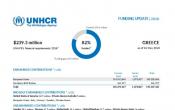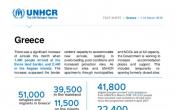Greece
Operation: Greece
Location
{"longitude":22,"latitude":39,"zoom_level":0,"iso_codes":"'GRC'"}
By clicking on the icons on the map, additional information is displayed.
Key Figures
| 2017 year-end results | |
| 37,600 | people received cash grants |
| 22,139 | urban accommodation places were established |
| 138 | projects to promote peaceful coexistence between host and displaced communities were implemented |
| 2018 planning figures | |
| 40,000 | people will receive cash grants |
| 30,000 | applicants will be provided with information on government status determination procedures |
| 27,000 | people will have places in urban accommodation setting |
| 5,000 | individuals will receive legal assistance |
More Information
People of Concern
| 2016 | 86,611 |

[["Refugees",21484],["Refugee-like situation",24943],["Asylum-seekers",39986],["Stateless",198]]
Loading ...
Greece
< Back
2017
{"categories":[2013,2014,2015,2016,2017,2018],"budget":[null,null,null,287.40068551,245.86626514,239.30721213],"expenditure":[null,null,null,183.87264811,217.74130145,null]}
{"categories":[2013,2014,2015,2016,2017,2018],"p1":[null,null,null,287.37282951,245.83840878,239.21825877],"p2":[null,null,null,0.027856,0.02785636,0.08895336],"p3":[null,null,null,null,null,null],"p4":[null,null,null,null,null,null]}
{"categories":[2013,2014,2015,2016,2017,2018],"p1":[null,null,null,183.84988105,217.73145452,null],"p2":[null,null,null,0.02276706,0.00984693,null],"p3":[null,null,null,null,null,null],"p4":[null,null,null,null,null,null]}
Loading ...
CHOOSE A YEAR
- 2015
- 2016
- 2017
- 2018
Operational context
After more than one million refugees and migrants transited through Greece in 2015 and 2016, the situation stabilized in 2017.As part of an overall strategic shift transiting from engagement in the sites and in the reception and identification centres (RICs) to urban areas and accommodation, the protection focus and delivery were consolidated to three key areas: 1) strengthening protection monitoring for better interventions, advocacy and planning; 2) building national protection systems through capacity building and piloting new initiatives; 3) mainstreaming protection in partnerships including with Governmental services and institutions. Enhanced protection monitoring in border areas, sites and urban areas, as well as strengthened cross-border coordination led to the generation of evidence-based information which was used for several advocacy interventions.
Despite UNHCR reducing its operational engagement, it continued to support new arrivals on the islands; technical interventions in some 50 sites and provision of assistance; creation of 22,000 accommodation places in apartments and hotels; and the introduction of cash-based interventions. In the course of the year UNHCR successfully transitioned out of site management support and assisted the Government reduce the number of sites to 25, including through the referral of people to UNHCR’s accommodation scheme.
Population trends
In 2017, an estimated 35,200 people arrived in Greece (29,700 by sea; 5,500 by land) returning to the pre-emergency levels of arrivals (41,000 people arrived in 2014). Sea arrivals consisted mostly of those with a refugee profile. People from Afghanistan, the Democratic Republic of the Congo, Iraq and Syria comprised 77 per cent of the sea arrivals, the majority of whom arrived in family groups. The number of unaccompanied children continued to increase in 2017 to some 3,350. In 2017, 10,360 people received international protection, which is a significant increase compared to the 8,700 people who, in total, received international protection between 2013 and 2016.Key achievements
- A total of 44,200 asylum-seekers and recognized refugees were accommodated by UNHCR and its partners.
- To respond to the increased number of UASC, and to respond to the inadequate capacity of shelters, UNHCR referred children over 18 years to its accommodation scheme and other alternatives such as supported independent living
Unmet needs
- Gaps in the provision of services and a weak involvement of key stakeholders remained, due the transition from NGOs to national authorities.
- The limited possibilities to expand the accommodation capacity outside the RICs due to local reactions is an impediment in the referral of people with specific needs to proper accommodation.
- There was a lack of alternative care options to shelter-based residential care for unaccompanied children.
Working environment
The operating environment in Greece has changed significantly since 2015, with the number of arrivals decreasing from 856,700 in 2015 to some 163,700 between January and August 2016. With the closure of borders along the Balkan route in March 2016, many people arriving in Greece have expressed their intention to seek asylum in Greece or apply for family reunification under the Dublin Regulation. By September 2016, only 5 per cent of the targeted 66,400 asylum-seekers had been relocated from Greece to other European Union countries since the programme began in November 2015.The Government of Greece assumes the overall leadership and coordination of the response to the refugee situation. An inter-ministerial coordination body has been established for the response. In addition, there are other coordination structures at the national and sub-national levels. The Government is responsible for registering and processing asylum claims. The local population and civil society have demonstrated generosity and solidarity towards refugees, and are playing a key role in providing assistance to refugees and migrants.
Although progress has been made, significant challenges related to reception and registration capacity remain. In response, UNHCR and the European Asylum Support Office (EASO) supported the Greek Asylum Service in carrying out a pre-registration exercise to ensure that people of concern in Greece have the opportunity to pursue available legal options. Reception capacity for refugees that have applied for the European Union relocation scheme on the islands and the mainland was increased from 2,500 places in April 2016 to some 10,500 places by the end of the August 2016.
In 2017, UNHCR will continue to work towards the establishment of additional reception places and to progressively substitute in-kind assistance with cash-based assistance. In particular, UNHCR plans to make available 20,000 reception/accommodation places for EU relocation candidates and vulnerable asylum-seekers on both the mainland and on islands, out of which at least 90 per cent of will meet international minimum standards. A lack of funding may hamper UNHCR’s ability to achieve this target.
Key Priorities
In 2017 UNHCR’s operation will focus on:• improving infrastructure at open accommodation sites, including transit facilities for unaccompanied children;
• establishing and further improving referral mechanisms for vulnerable individuals, asylum applicants, medical cases and others with specific needs to relevant services;
• strengthening community-based protection interventions in open accommodation sites and implementing peaceful co-existence projects benefitting refugee and host communities;
• supporting partners to establish informal education activities through logistics support, as well as advocating with Greek authorities for refugee children to have access to schools;
• implementing a cash-based assistance programme targeting 30,000 refugees;
• strengthening legal aid and counselling on the asylum procedure, family reunification and the relocation programme;
• maintaining “blue dot hubs” to ensure the provision of key services for children and families, including child-friendly spaces, psychosocial support and legal counselling, and safe areas to sleep for women and children; and
• preventing and responding to sexual and gender-based violence by improving referral of survivors to appropriate services on the islands and mainland.

